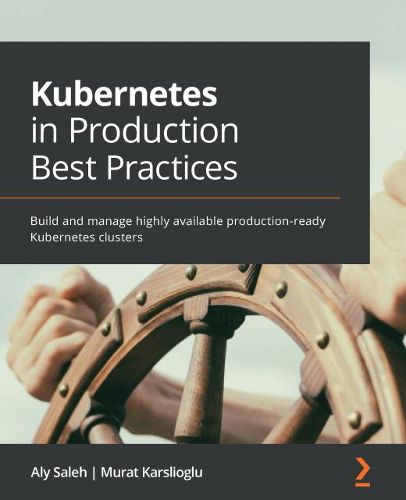Readings Newsletter
Become a Readings Member to make your shopping experience even easier.
Sign in or sign up for free!
You’re not far away from qualifying for FREE standard shipping within Australia
You’ve qualified for FREE standard shipping within Australia
The cart is loading…






This title is printed to order. This book may have been self-published. If so, we cannot guarantee the quality of the content. In the main most books will have gone through the editing process however some may not. We therefore suggest that you be aware of this before ordering this book. If in doubt check either the author or publisher’s details as we are unable to accept any returns unless they are faulty. Please contact us if you have any questions.
Design, build, and operate scalable and reliable Kubernetes infrastructure for production
Key Features
Implement industry best practices to build and manage production-grade Kubernetes infrastructure Learn how to architect scalable Kubernetes clusters, harden container security, and fine-tune resource management Understand, manage, and operate complex business workloads confidently
Book DescriptionAlthough out-of-the-box solutions can help you to get a cluster up and running quickly, running a Kubernetes cluster that is optimized for production workloads is a challenge, especially for users with basic or intermediate knowledge. With detailed coverage of cloud industry standards and best practices for achieving scalability, availability, operational excellence, and cost optimization, this Kubernetes book is a blueprint for managing applications and services in production.
You’ll discover the most common way to deploy and operate Kubernetes clusters, which is to use a public cloud-managed service from AWS, Azure, or Google Cloud Platform (GCP). This book explores Amazon Elastic Kubernetes Service (Amazon EKS), the AWS-managed version of Kubernetes, for working through practical exercises. As you get to grips with implementation details specific to AWS and EKS, you’ll understand the design concepts, implementation best practices, and configuration applicable to other cloud-managed services. Throughout the book, you’ll also discover standard and cloud-agnostic tools, such as Terraform and Ansible, for provisioning and configuring infrastructure.
By the end of this book, you’ll be able to leverage Kubernetes to operate and manage your production environments confidently.
What you will learn
Explore different infrastructure architectures for Kubernetes deployment Implement optimal open source and commercial storage management solutions Apply best practices for provisioning and configuring Kubernetes clusters, including infrastructure as code (IaC) and configuration as code (CAC) Configure the cluster networking plugin and core networking components to get the best out of them Secure your Kubernetes environment using the latest tools and best practices Deploy core observability stacks, such as monitoring and logging, to fine-tune your infrastructure
Who this book is forThis book is for cloud infrastructure experts, DevOps engineers, site reliability engineers, and engineering managers looking to design and operate Kubernetes infrastructure for production. Basic knowledge of Kubernetes, Terraform, Ansible, Linux, and AWS is needed to get the most out of this book.
$9.00 standard shipping within Australia
FREE standard shipping within Australia for orders over $100.00
Express & International shipping calculated at checkout
This title is printed to order. This book may have been self-published. If so, we cannot guarantee the quality of the content. In the main most books will have gone through the editing process however some may not. We therefore suggest that you be aware of this before ordering this book. If in doubt check either the author or publisher’s details as we are unable to accept any returns unless they are faulty. Please contact us if you have any questions.
Design, build, and operate scalable and reliable Kubernetes infrastructure for production
Key Features
Implement industry best practices to build and manage production-grade Kubernetes infrastructure Learn how to architect scalable Kubernetes clusters, harden container security, and fine-tune resource management Understand, manage, and operate complex business workloads confidently
Book DescriptionAlthough out-of-the-box solutions can help you to get a cluster up and running quickly, running a Kubernetes cluster that is optimized for production workloads is a challenge, especially for users with basic or intermediate knowledge. With detailed coverage of cloud industry standards and best practices for achieving scalability, availability, operational excellence, and cost optimization, this Kubernetes book is a blueprint for managing applications and services in production.
You’ll discover the most common way to deploy and operate Kubernetes clusters, which is to use a public cloud-managed service from AWS, Azure, or Google Cloud Platform (GCP). This book explores Amazon Elastic Kubernetes Service (Amazon EKS), the AWS-managed version of Kubernetes, for working through practical exercises. As you get to grips with implementation details specific to AWS and EKS, you’ll understand the design concepts, implementation best practices, and configuration applicable to other cloud-managed services. Throughout the book, you’ll also discover standard and cloud-agnostic tools, such as Terraform and Ansible, for provisioning and configuring infrastructure.
By the end of this book, you’ll be able to leverage Kubernetes to operate and manage your production environments confidently.
What you will learn
Explore different infrastructure architectures for Kubernetes deployment Implement optimal open source and commercial storage management solutions Apply best practices for provisioning and configuring Kubernetes clusters, including infrastructure as code (IaC) and configuration as code (CAC) Configure the cluster networking plugin and core networking components to get the best out of them Secure your Kubernetes environment using the latest tools and best practices Deploy core observability stacks, such as monitoring and logging, to fine-tune your infrastructure
Who this book is forThis book is for cloud infrastructure experts, DevOps engineers, site reliability engineers, and engineering managers looking to design and operate Kubernetes infrastructure for production. Basic knowledge of Kubernetes, Terraform, Ansible, Linux, and AWS is needed to get the most out of this book.